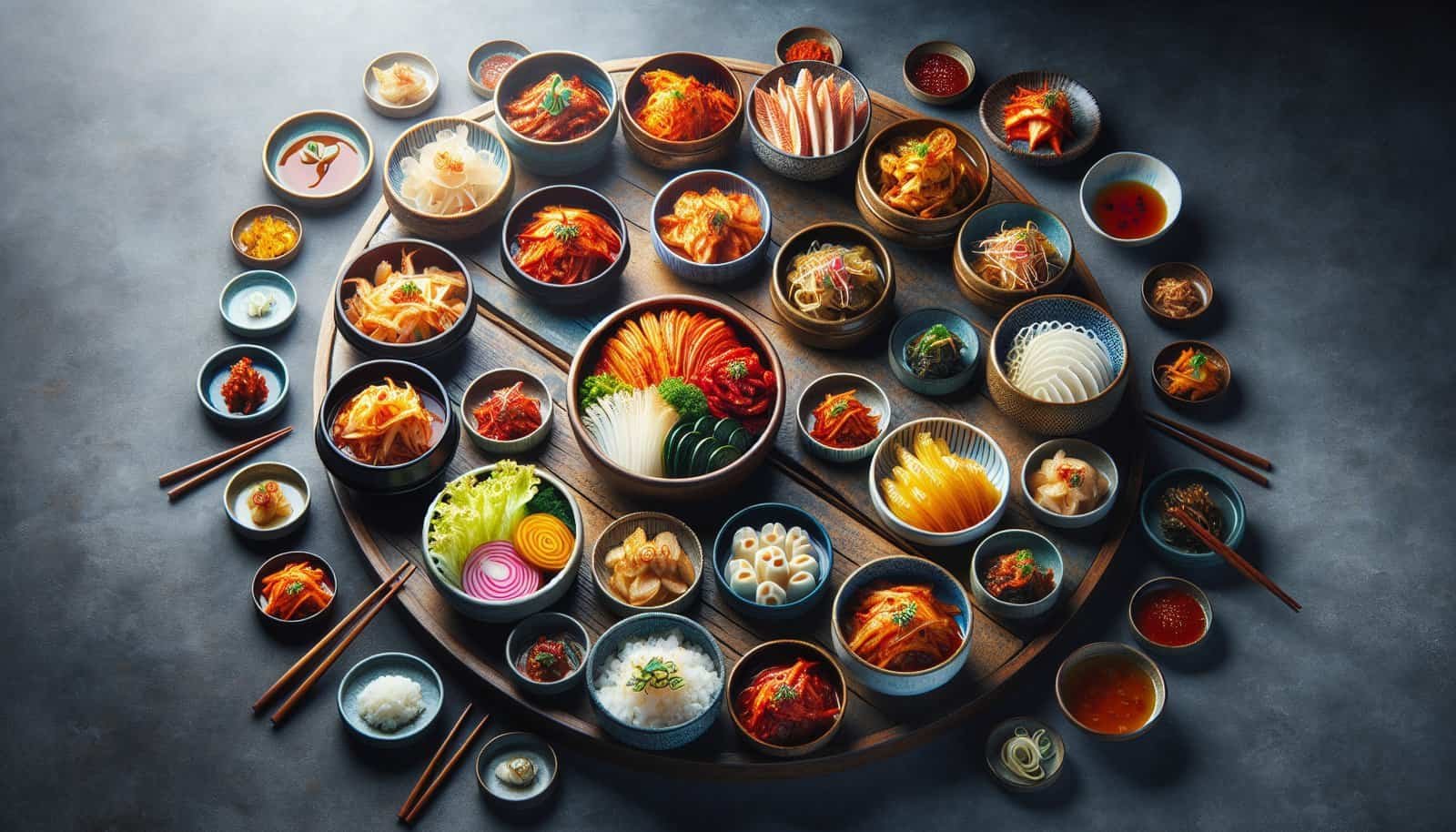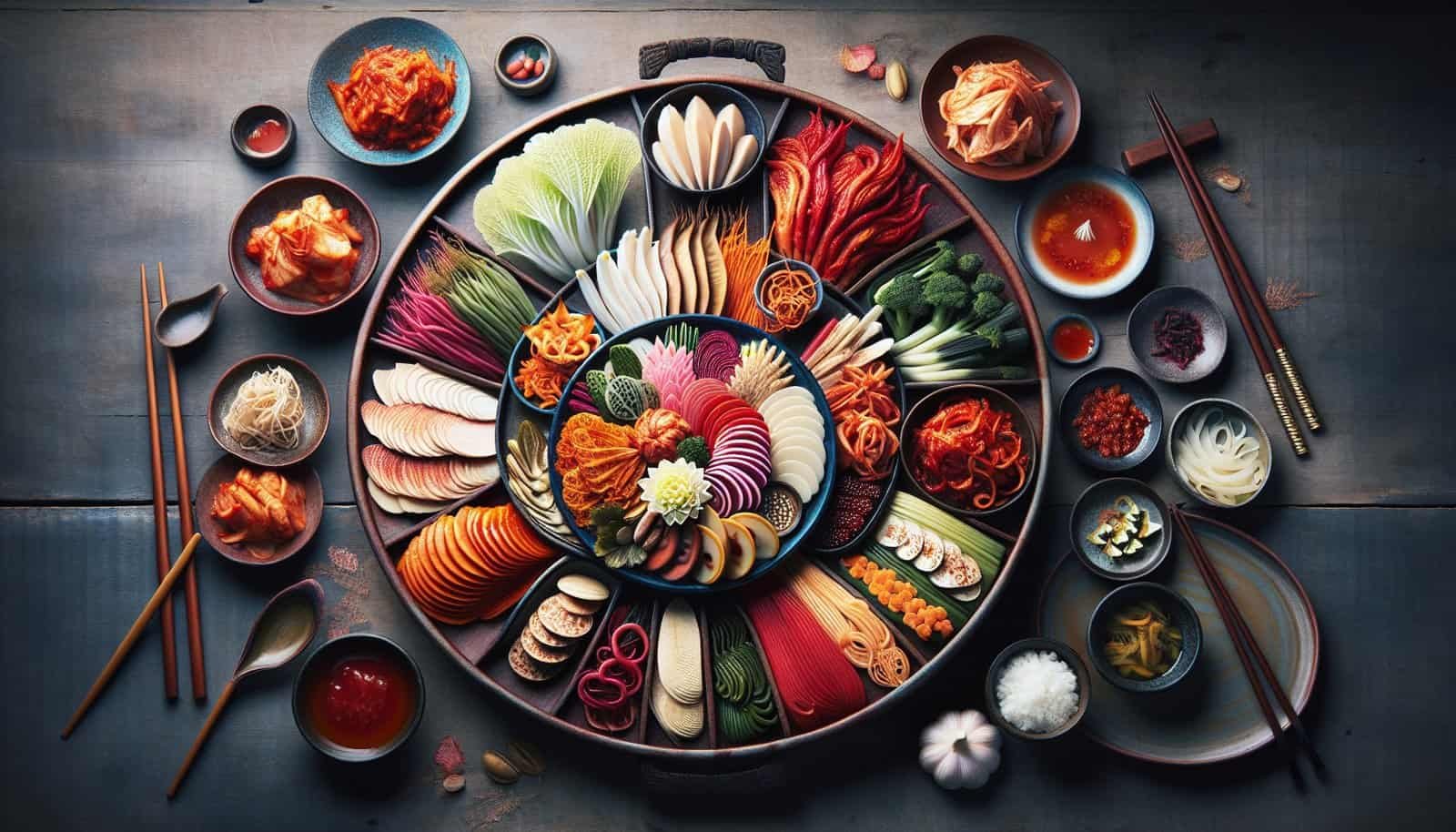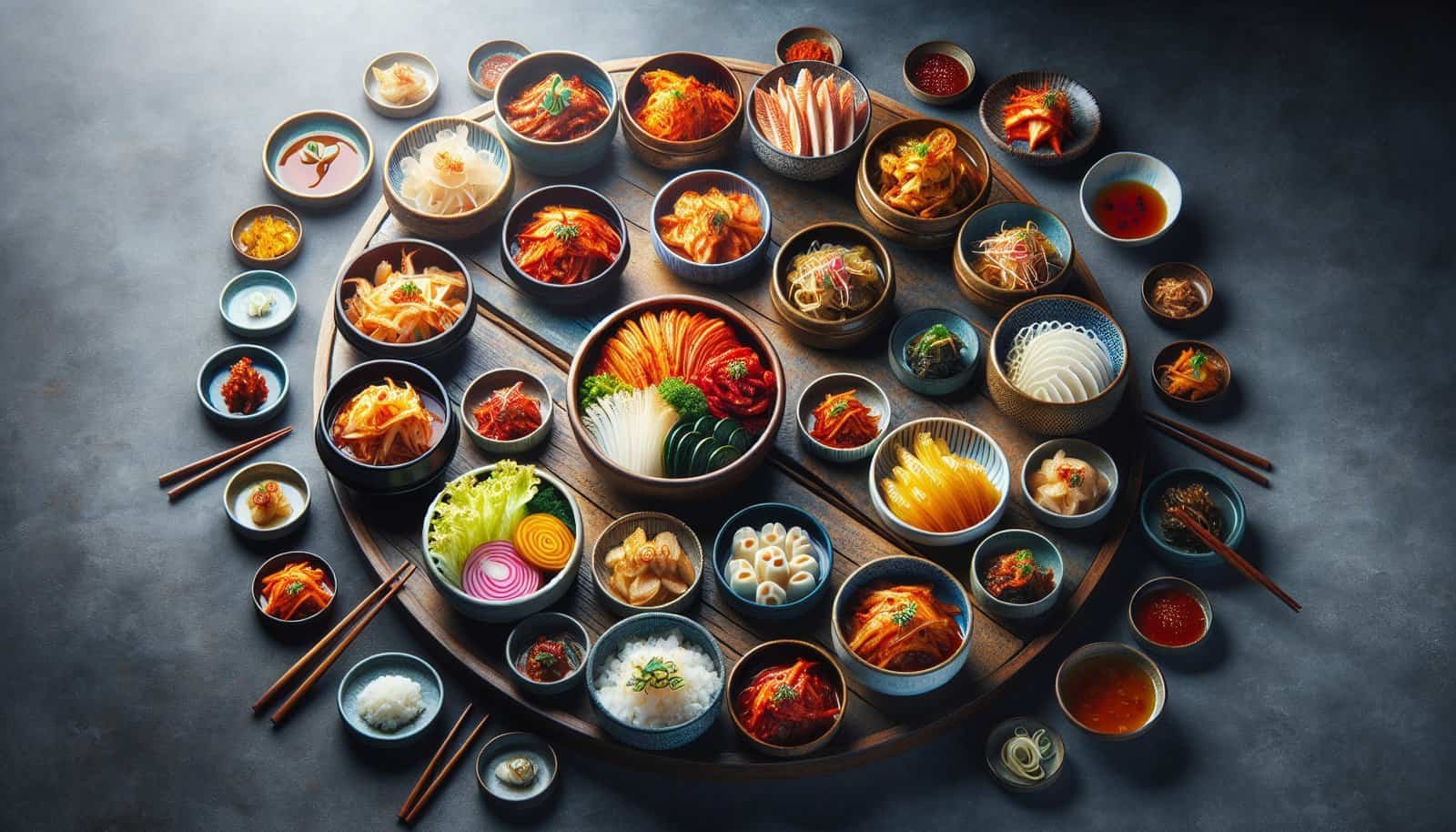Imagine yourself sitting down at a traditional Korean restaurant, eagerly awaiting the arrival of your meal. As the server places the beautifully arranged dishes in front of you, your eyes widen with anticipation. Each dish appears to be a work of art, with vibrant colors, intricate patterns, and a careful balance of ingredients. You can’t help but wonder, what is the secret behind the art of presentation in Korean cuisine? In this article, we will explore the fascinating and visually stunning world of Korean cuisine, and discover the cultural significance and techniques behind its remarkable presentation. So grab a seat, and prepare to be dazzled by the artistry of Korean culinary traditions.

Understanding Korean Cuisine
Korean cuisine is known for its rich and diverse flavors, which are carefully crafted to achieve a perfect balance of taste. Traditional Korean cuisine focuses on incorporating a variety of ingredients to create harmonious and well-rounded dishes. It not only stimulates the taste buds but also pleases the eyes with its stunning presentation.
Traditional Elements
Traditional Korean cuisine is deeply rooted in ancient culinary practices that have been passed down through generations. It encompasses a wide range of dishes, including kimchi, bulgogi, bibimbap, and a plethora of side dishes known as banchan. These dishes comprise various elements such as grains, meats, vegetables, and condiments, all meticulously prepared to create a balanced and nourishing meal.
Focus on Balance
In Korean cuisine, achieving balance is key. It involves the harmonious combination of flavors, textures, and colors to create a meal that appeals to all the senses. This balance is not only important for the taste of the food but also for its nutritional value. Korean cuisine often incorporates different food groups such as grains, vegetables, proteins, and fermented foods to ensure a well-rounded and complete meal.
Harmony of Flavors
Korean cuisine is renowned for its bold and distinct flavors. The combination of sweet, spicy, salty, and savory flavors creates a symphony of tastes that delight the palate. The use of various seasonings and ingredients like gochujang (red chili paste), soy sauce, garlic, and sesame oil enhances the overall flavor profile of Korean dishes. The harmony of these flavors is carefully balanced to create a uniquely satisfying dining experience.
The Importance of Presentation
In Korean culture, the presentation of food holds great significance. It is believed that the first impression of a dish is crucial to the overall dining experience. The art of presentation in Korean cuisine goes beyond just making the food look visually appealing. It aims to enhance the dining experience, engage the senses, and convey the utmost respect for the food being served.
First Impression Matters
The visual appeal of a dish sets the stage for the entire meal. Koreans believe that a beautifully presented dish not only whets the appetite but also showcases the skill and care of the cook. The first glimpse of a well-plated dish entices the diners and creates anticipation for the delightful flavors that await.
Visual Appeal
The art of presentation in Korean cuisine emphasizes aesthetics. The arrangement of colorful ingredients, the use of contrasting textures, and the incorporation of garnishes and condiments all contribute to the visual appeal of a dish. From the vibrant assortment of banchan to the intricate placement of ingredients in a bowl of bibimbap, Korean dishes are designed to be visually striking.
Enhancing the Dining Experience
Presentation in Korean cuisine is not just about appearance; it also aims to enhance the overall dining experience. The careful arrangement of ingredients and the use of different colors, textures, and shapes create a feast for the eyes. It adds an element of excitement and anticipation to the meal, making it a memorable and enjoyable experience.
Principles of Presentation
To achieve the artful presentation that is so characteristic of Korean cuisine, certain principles are followed. These principles guide the arrangement of ingredients, the use of garnishes, and the overall visual composition of the dish.
Balance and Harmony
Balance and harmony are fundamental principles in Korean cuisine. The arrangement of ingredients should be symmetrical or asymmetrical, creating a visual balance on the plate. The flavors and textures of the dish should also be harmonious, with each component complementing and enhancing the others.
Color and Texture
Color plays a crucial role in Korean food presentation. Vibrant and contrasting colors are used to create visual interest and appeal. Vegetables, fruits, and pickled ingredients add pops of color to dishes, making them visually enticing. Furthermore, the incorporation of different textures, such as crispy, chewy, and creamy, adds depth and complexity to the dining experience.
Proper Use of Garnishes
Garnishes are used not just for decorative purposes but also to add flavor and texture to a dish. Korean cuisine makes use of various garnishes, such as sliced scallions, sesame seeds, toasted seaweed, and chili threads, to enhance the appearance and taste of the food. The garnishes should be used sparingly and thoughtfully, complementing the overall presentation without overpowering the dish.
Table Setting and Serveware
The presentation of Korean cuisine extends beyond the visual appeal of the food itself. The table setting and serveware play a crucial role in enhancing the overall dining experience and showcasing the beauty of the food.
Tablecloth and Tableware
Traditionally, Korean meals are served on a low table with diners sitting on cushions or mats. The table is often adorned with a colorful tablecloth or a traditional embroidered cloth known as a “ddimul.” The choice of tablecloth and tableware is important, as they contribute to the visual theme and atmosphere of the meal.
Bowls, Plates, and Utensils
Korean cuisine is typically served in a variety of bowls, plates, and utensils, each specifically chosen to complement the dish being served. From the iconic stainless steel bowls used for rice and soup to the dainty porcelain dishes for banchan, the serveware adds elegance and sophistication to the dining experience. The utensils, such as chopsticks and spoons, are also carefully selected, taking into account their quality, design, and functionality.

Proper Plating Techniques
Plating techniques play a vital role in the art of presentation in Korean cuisine. The arrangement of ingredients on the plate not only creates a visually appealing dish but also affects the way the flavors and textures interact.
Symmetry and Asymmetry
Plating in Korean cuisine often follows a principle of symmetry or asymmetry. Symmetrical plating creates a sense of order and balance, with ingredients arranged in a mirror-like fashion. Asymmetrical plating, on the other hand, adds a touch of creativity and artistry, creating visual interest and excitement.
Layering and Stacking
Layering and stacking are common techniques used in Korean cuisine to create visually striking dishes. By carefully layering ingredients, such as rice, vegetables, and proteins, in a bowl or on a plate, chefs create a complex and visually appealing dish. Stacking ingredients, such as grilled meats or seafood, adds height and dimension to the presentation.
Arrangement and Spacing
The arrangement of ingredients on the plate is crucial in Korean cuisine. Ingredients should be thoughtfully placed, with attention to color, shape, and size. Spacing between the elements allows each component to be showcased individually, while also contributing to the overall visual harmony of the dish.
Artistic Elements in Presentation
Korean cuisine takes presentation to an artistic level by incorporating various techniques and elements to create visually stunning dishes.
Vegetable and Fruit Carving
Vegetable and fruit carving is a traditional art form in Korean cuisine. Skilled chefs carve intricate shapes, such as flowers, animals, and decorative patterns, using a knife or specialized carving tools. These edible sculptures add a touch of elegance and beauty to the dish, elevating it to a work of art.
Food Sculptures
In addition to vegetable and fruit carving, Korean cuisine also utilizes food sculptures made from various ingredients. Whether it be a carved radish rose or a seafood sculpture, these edible artworks serve as focal points on the plate, capturing the attention and admiration of the diners.
Creative Plating Styles
Korean cuisine encourages chefs to explore their creativity and experiment with unique plating styles. From arranging ingredients to mimic landscapes or traditional motifs to using unconventional shapes and containers, the possibilities for creative plating are endless. These innovative presentations not only showcase the chef’s skill and imagination but also add an element of surprise and delight to the dining experience.

Influences from Traditional Korean Art
The art of presentation in Korean cuisine draws inspiration from traditional Korean art forms, which are deeply rooted in Korean culture and history.
Subtle Beauty of Nature
Natural elements, such as flowers, plants, and landscapes, have long been an inspiration for Korean artists. Similarly, presentation in Korean cuisine often reflects the delicate beauty of nature. The use of fresh and seasonal ingredients, the incorporation of floral and leaf-shaped garnishes, and the emphasis on natural colors evoke a sense of the outdoors and celebrate the beauty of the natural world.
Incorporation of Symbolism
Symbolism is an integral part of traditional Korean art, and this symbolism is also reflected in the presentation of Korean cuisine. Certain ingredients, colors, and arrangements carry symbolic meanings and are used to convey wishes for good fortune, prosperity, and harmony. By incorporating these symbolic elements into the presentation of dishes, Korean cuisine not only nourishes the body but also appeals to the deeper cultural and spiritual significance.
Use of Traditional Patterns
Traditional patterns, such as the iconic “janggu” drum pattern or the intricate “bojagi” patchwork, find their way into the art of presentation in Korean cuisine. These patterns are often used as decorative accents on plates, bowls, and tableware, creating a visual connection to Korea’s rich cultural heritage.
Importance of Seasonality
Seasonality plays a significant role in Korean cuisine, and this is reflected in the art of presentation.
Incorporating Seasonal Ingredients
Korean cuisine places great emphasis on using fresh and seasonal ingredients. The availability of ingredients is often celebrated, and dishes are designed to highlight the flavors and characteristics of each season. From vibrant spring vegetables to hearty autumn produce, the use of seasonal ingredients adds depth and authenticity to Korean dishes.
Celebrate the Flavors of Each Season
Just as the ingredients change with the seasons, so do the flavors and textures of Korean dishes. The presentation of these seasonal dishes aims to capture the essence of each season, whether it be through the vibrant colors of spring, the cooling freshness of summer, the rich earthiness of fall, or the comforting warmth of winter. By celebrating the flavors of each season, Korean cuisine offers a unique and ever-evolving dining experience.

Responsive Presentation
Presentation in Korean cuisine isn’t just a one-size-fits-all approach. The art of presentation is adaptable, taking into account the preferences, dietary restrictions, and cultural backgrounds of the diners.
Adapting to the Diners
Korean cuisine is incredibly versatile, and presentation styles can be customized to accommodate different tastes and preferences. The art of presentation takes into consideration the individual diners, their cultural background, and their dietary restrictions to create a dining experience that is both inclusive and enjoyable for everyone.
Customizing Presentation Styles
Whether it be adjusting the level of spiciness, catering to vegetarian or vegan diets, or accommodating specific allergies or intolerances, presentation in Korean cuisine is flexible and can be tailored to meet the unique needs of each diner. Chefs take pride in their ability to customize the presentation styles, ensuring that every diner’s experience is memorable and satisfying.
Modern Innovations
While traditional elements and techniques form the foundation of Korean cuisine’s presentation, there is also room for modern innovations and creative experimentation.
Fusion of Tradition and Creativity
Korean cuisine has embraced fusion in recent years, merging traditional flavors and techniques with influences from other cuisines. This fusion extends to the art of presentation as well. Chefs are exploring new plating techniques, combining traditional elements with contemporary aesthetics, and pushing the boundaries of what is considered “traditional” Korean presentation.
Incorporating Modern Techniques
Advancements in technology and culinary techniques have also found their way into the art of presentation in Korean cuisine. Chefs are utilizing innovative tools and methods to create visually stunning dishes. Molecular gastronomy, edible foams, and spherification are just a few examples of modern techniques being incorporated into the presentation of Korean dishes, adding an element of surprise and innovation.
In conclusion, the art of presentation in Korean cuisine is a multi-faceted and intricate process. It encompasses principles of balance, harmony, and aesthetics, while also drawing inspiration from traditional Korean art forms. The importance of presentation goes beyond just the visual appeal; it enhances the dining experience, engages the senses, and reflects the respect and tradition deeply ingrained in Korean culture. Whether it be through symmetrical plating, vegetable carvings, or the incorporation of seasonal ingredients, presentation in Korean cuisine is a true art form that continues to evolve and captivate diners around the world.

